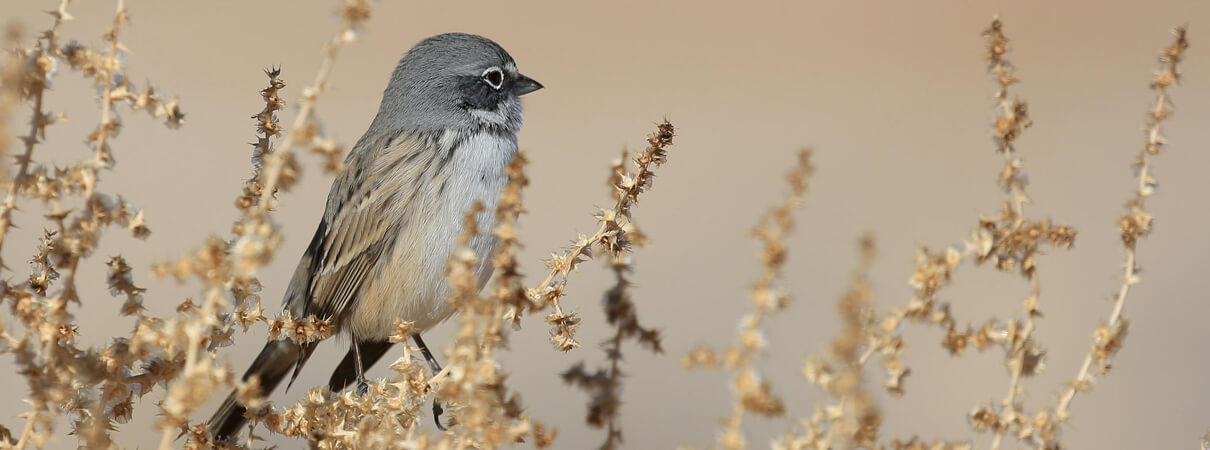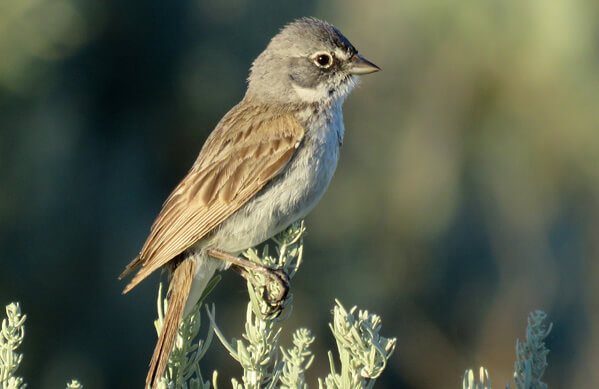 “Throughout the arid West the Americans have found a secret treasure … a stern and desolate country, a high bare country, a country brimming with a beauty not to be found elsewhere.” So wrote Bernard DeVoto, a historian of the American West, in 1943.
“Throughout the arid West the Americans have found a secret treasure … a stern and desolate country, a high bare country, a country brimming with a beauty not to be found elsewhere.” So wrote Bernard DeVoto, a historian of the American West, in 1943.
One of the treasures of sage country is Sagebrush Sparrow, with the male's trilling song and bell-like tink call (given by both sexes). Although fairly common in suitable habitat, this species is frequently overlooked because of its habit of staying on the ground and under cover.
Like Greater Sage-Grouse, Sagebrush Sparrows require healthy sagebrush for successful breeding — so much so that the birds will abandon degraded sage habitats. According to the Sage Grouse Initiative, only 56 percent of the sagebrush ecosystem remains, making it one of our most endangered habitats.
Sagebrush Sparrow was once lumped with a West Coast species, Bell's Sparrow, into a single species known as the Sage Sparrow. The species was split by the American Ornithologists' Union in 2013 on the basis of genetic, morphologic, and ecological differences.
Bird of the Western Interior
This bird breeds in the interior of the western United States, between the Rocky Mountains and the western coastal mountain ranges such as the Cascades. It winters in the Mexican border states and northern Sonora and Chihuahua.
Across its range, overgrazing and the presence of cheatgrass and other invasive plants are two of the main threats to this species' habitat. In addition to habitat loss, fragmentation can make it easier for the parasitic Brown-headed Cowbird to find and lay eggs in the sparrows' nests, with the larger cowbird fledglings out-competing the sparrows.
Sagebrush Sparrows tend to stay faithful to their home ranges, returning year after year to the same areas both during the nesting season and on the wintering grounds.
Sign up for ABC's eNews to learn how you can help protect birds
Desert Dweller
Omnivorous and opportunistic during the breeding season, Sagebrush Sparrows feed on beetles, grasshoppers and other insects, spiders, seeds, small fruits, and succulent vegetation. During the nonbreeding season, the Sagebrush Sparrow feeds mostly on seeds.

Sagebrush Sparrow by MTKhaled mahmud, Shutterstock
Like Grasshopper Sparrow, this species forages primarily on ground, usually near or under the edges of shrubs. It also gleans prey from lower stems of shrubs and leaves. As a desert-dwelling species, it gets most of its water from food.
Sagebrush Sparrows usually hop or walk on the ground while foraging, often with tails raised in the air. When perched, they twitch their tails in an up-and-down motion like a phoebe.
Saving Sagebrush — and Sagebrush Sparrow
Although the Sagebrush Sparrow is still considered fairly common, studies of its winter range and habitat preferences are incomplete. These areas, along with availability of suitable stopover sites, may prove to be limiting factors on the species' population.
Through our BirdScapes approach to migratory bird conservation, American Bird Conservancy is working to address the challenges that Sagebrush Sparrow and other birds face across their full annual life-cycles, whether on the breeding grounds, wintering grounds, or in between.
Our work with Pronature Noreste in northern Mexico helps ranchers manage their grasslands to benefit birds like Sagebrush Sparrow, Baird's Sparrow, and Worthen's Sparrow — a species found only in Mexico's Chihuahuan Desert.
Our work for Greater Sage-Grouse also benefits the Sagebrush Sparrow. We continue to advocate for keeping strong management plans for the grouse in place, including protection of the large, intact sagebrush stands needed by both grouse and sparrow.
Donate to support ABC's conservation mission!



















































